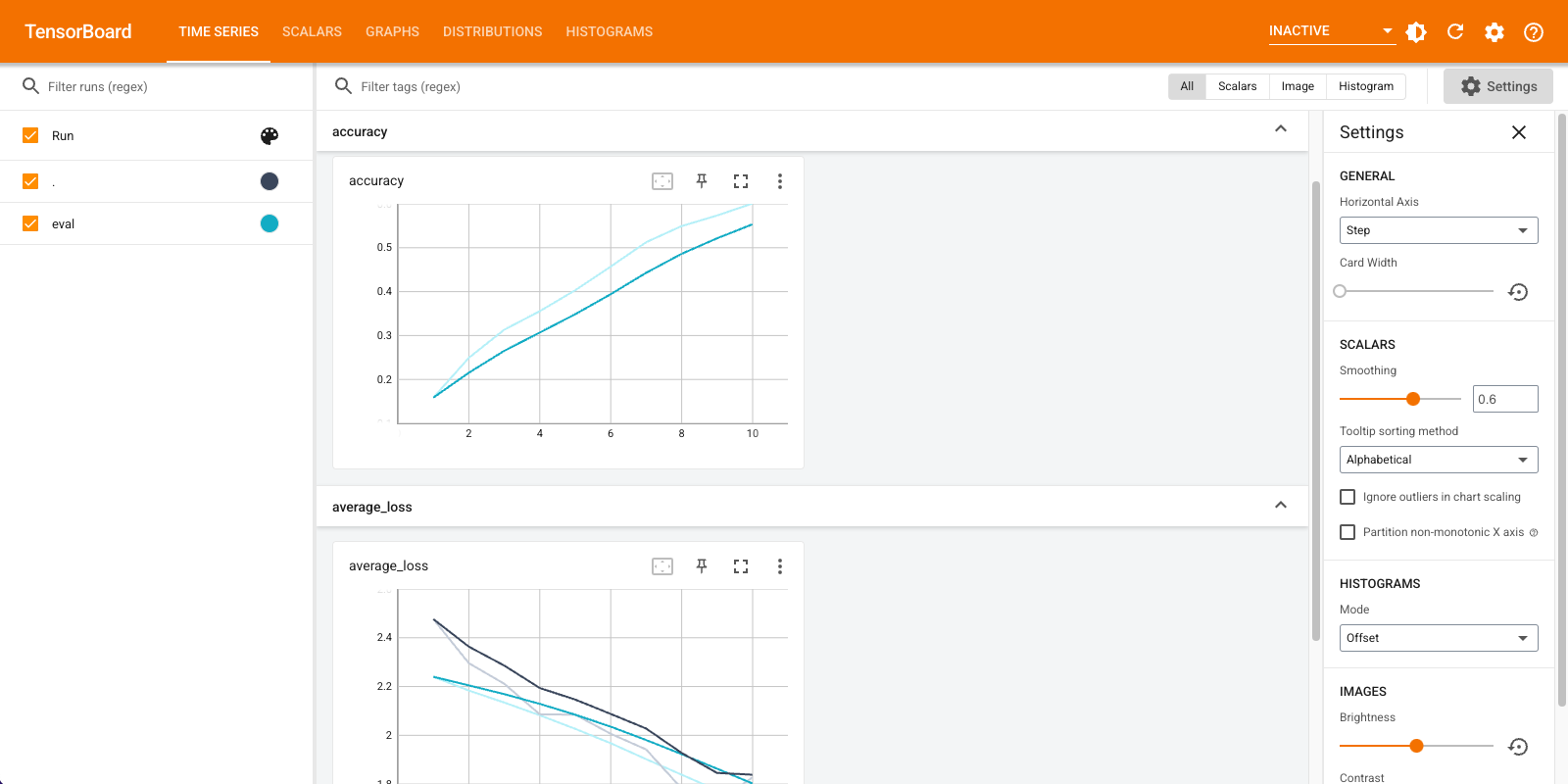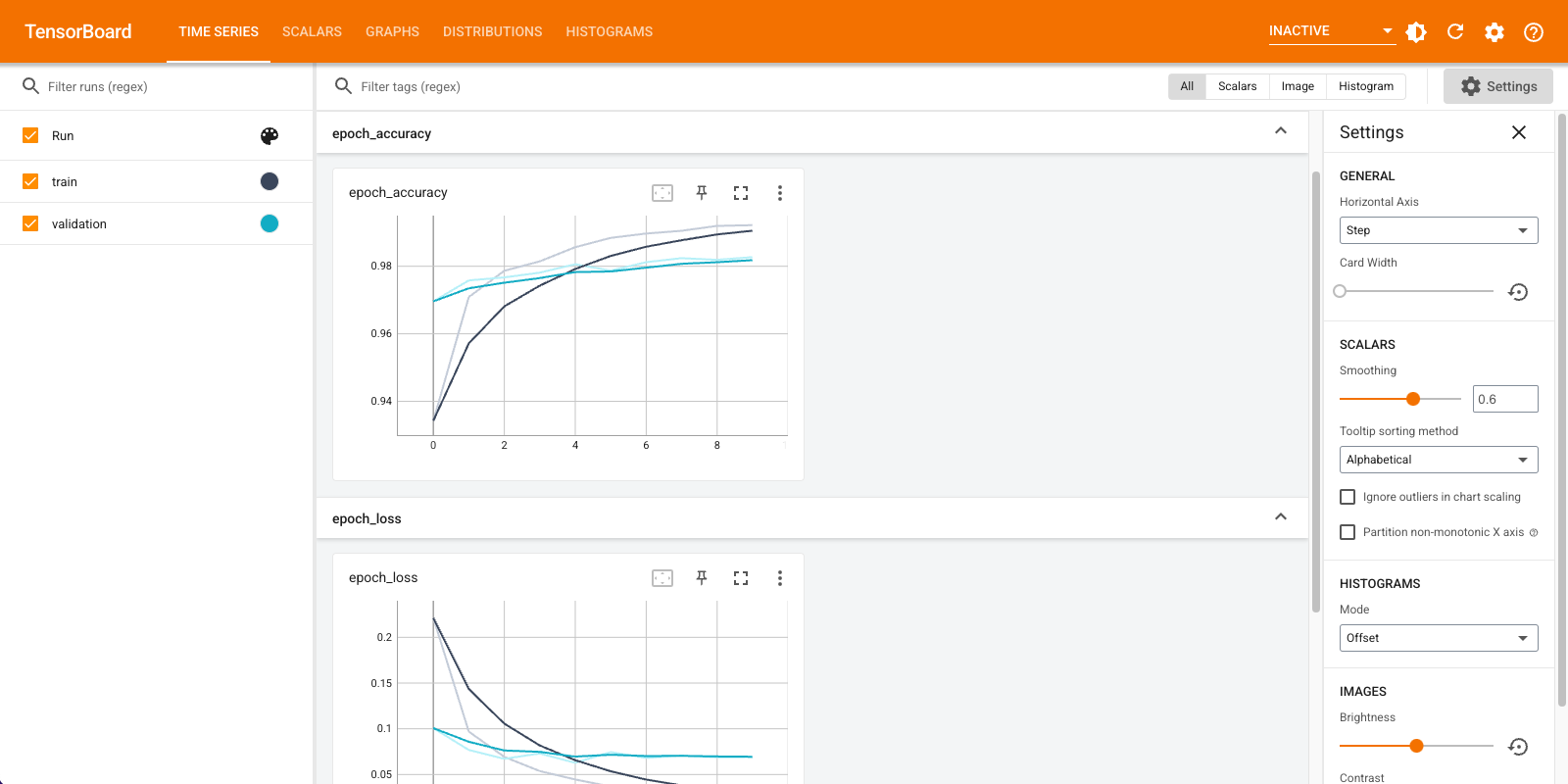 在 TensorFlow.org 上查看 在 TensorFlow.org 上查看
|
 在 Google Colab 中运行 在 Google Colab 中运行
|
 在 GitHub 上查看源代码 在 GitHub 上查看源代码
|
 下载笔记本 下载笔记本
|
TensorBoard 是 TensorFlow 中用于提供度量和可视化的内置工具。常见的机器学习实验指标,例如准确率和损失,可以在 TensorBoard 中跟踪和显示。TensorBoard 与 TensorFlow 1 和 2 代码兼容。
在 TensorFlow 1 中,tf.estimator.Estimator 默认情况下会为 TensorBoard 保存摘要。相比之下,在 TensorFlow 2 中,可以使用 tf.keras.callbacks.TensorBoard 回调 保存摘要。
本指南演示了如何使用 TensorBoard,首先是在 TensorFlow 1 中使用估计器,然后是如何在 TensorFlow 2 中执行等效过程。
设置
import tensorflow.compat.v1 as tf1
import tensorflow as tf
import tempfile
import numpy as np
import datetime
%load_ext tensorboard
mnist = tf.keras.datasets.mnist # The MNIST dataset.
(x_train, y_train),(x_test, y_test) = mnist.load_data()
x_train, x_test = x_train / 255.0, x_test / 255.0
TensorFlow 1:使用 tf.estimator 的 TensorBoard
在本 TensorFlow 1 示例中,您将实例化一个 tf.estimator.DNNClassifier,在 MNIST 数据集上对其进行训练和评估,并使用 TensorBoard 显示指标
%reload_ext tensorboard
feature_columns = [tf1.feature_column.numeric_column("x", shape=[28, 28])]
config = tf1.estimator.RunConfig(save_summary_steps=1,
save_checkpoints_steps=1)
path = tempfile.mkdtemp()
classifier = tf1.estimator.DNNClassifier(
feature_columns=feature_columns,
hidden_units=[256, 32],
optimizer=tf1.train.AdamOptimizer(0.001),
n_classes=10,
dropout=0.1,
model_dir=path,
config = config
)
train_input_fn = tf1.estimator.inputs.numpy_input_fn(
x={"x": x_train},
y=y_train.astype(np.int32),
num_epochs=10,
batch_size=50,
shuffle=True,
)
test_input_fn = tf1.estimator.inputs.numpy_input_fn(
x={"x": x_test},
y=y_test.astype(np.int32),
num_epochs=10,
shuffle=False
)
train_spec = tf1.estimator.TrainSpec(input_fn=train_input_fn, max_steps=10)
eval_spec = tf1.estimator.EvalSpec(input_fn=test_input_fn,
steps=10,
throttle_secs=0)
tf1.estimator.train_and_evaluate(estimator=classifier,
train_spec=train_spec,
eval_spec=eval_spec)
%tensorboard --logdir {classifier.model_dir}

TensorFlow 2:使用 Keras 回调和 Model.fit 的 TensorBoard
在本 TensorFlow 2 示例中,您将使用 tf.keras.callbacks.TensorBoard 回调创建和存储日志,并训练模型。回调会跟踪每个纪元的准确率和损失。它在 callbacks 列表中传递给 Model.fit。
%reload_ext tensorboard
def create_model():
return tf.keras.models.Sequential([
tf.keras.layers.Flatten(input_shape=(28, 28), name='layers_flatten'),
tf.keras.layers.Dense(512, activation='relu', name='layers_dense'),
tf.keras.layers.Dropout(0.2, name='layers_dropout'),
tf.keras.layers.Dense(10, activation='softmax', name='layers_dense_2')
])
model = create_model()
model.compile(optimizer='adam',
loss='sparse_categorical_crossentropy',
metrics=['accuracy'],
steps_per_execution=10)
log_dir = tempfile.mkdtemp()
tensorboard_callback = tf.keras.callbacks.TensorBoard(
log_dir=log_dir,
histogram_freq=1) # Enable histogram computation with each epoch.
model.fit(x=x_train,
y=y_train,
epochs=10,
validation_data=(x_test, y_test),
callbacks=[tensorboard_callback])
%tensorboard --logdir {tensorboard_callback.log_dir}

后续步骤
- 在 入门 指南中了解有关 TensorBoard 的更多信息。
- 对于更低级的 API,请参阅 tf.summary 迁移到 TensorFlow 2 指南。
